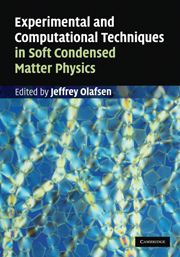Book contents
- Frontmatter
- Contents
- Contributors
- 1 Microscopy of soft materials
- 2 Computational methods to study jammed systems
- 3 Soft random solids: particulate gels, compressed emulsions, and hybrid materials
- 4 Langmuir monolayers
- 5 Computer modeling of granular rheology
- 6 Rheological and microrheological measurements of soft condensed matter
- 7 Particle-based measurement techniques for soft matter
- 8 Cellular automata models of granular flow
- 9 Photoelastic materials
- 10 Image acquisition and analysis in soft condensed matter
- 11 Structure and patterns in bacterial colonies
- Index
- References
7 - Particle-based measurement techniques for soft matter
Published online by Cambridge University Press: 05 July 2014
- Frontmatter
- Contents
- Contributors
- 1 Microscopy of soft materials
- 2 Computational methods to study jammed systems
- 3 Soft random solids: particulate gels, compressed emulsions, and hybrid materials
- 4 Langmuir monolayers
- 5 Computer modeling of granular rheology
- 6 Rheological and microrheological measurements of soft condensed matter
- 7 Particle-based measurement techniques for soft matter
- 8 Cellular automata models of granular flow
- 9 Photoelastic materials
- 10 Image acquisition and analysis in soft condensed matter
- 11 Structure and patterns in bacterial colonies
- Index
- References
Summary
Introduction
Optical measurement techniques are ubiquitous across many disciplines of science. Since so much of our everyday interaction with the world around us is based on vision, optical investigations feel very natural and, when possible, are often the preferred interrogation technique.
While the sophistication of optical measurement has certainly increased with time, the basic idea remains the same: the physical system of interest is illuminated with visible light (which is assumed to interact with the system only passively) and is imaged by a photosensitive detector. In the early days of optical measurement, film was the preferred medium, and optical studies were by and large static. The few dynamic measurements that were made involved long or multiple exposures and tedious reconstructions done by hand [1]. With the advent of digital imaging and large-scale digital storage, however, optical measurements can now easily address dynamic questions, with enough temporal and spatial resolution to measure a wide range of quantities and sufficient storage to gather enough samples for well-converged statistics. In physics, we are often interested in velocities and accelerations, which give us access to momentum, energy, and force; such dynamic quantities are now accessible with imaging techniques.
- Type
- Chapter
- Information
- Publisher: Cambridge University PressPrint publication year: 2010



